Key takeaways
- Narrative techniques enhance the emotional depth and immersive quality of films, making viewers active participants in the storytelling process.
- Richard Linklater’s style emphasizes natural dialogue and the exploration of time, allowing for intimate character connections and personal reflections.
- His use of non-linear storytelling and revisiting themes creates a rhythm that deepens audience engagement and understanding of the narrative.
- Applying Linklater’s methods in film reviews involves focusing on subtle details, embracing ambiguity, and highlighting repeating scenes that gain new meaning upon reflection.
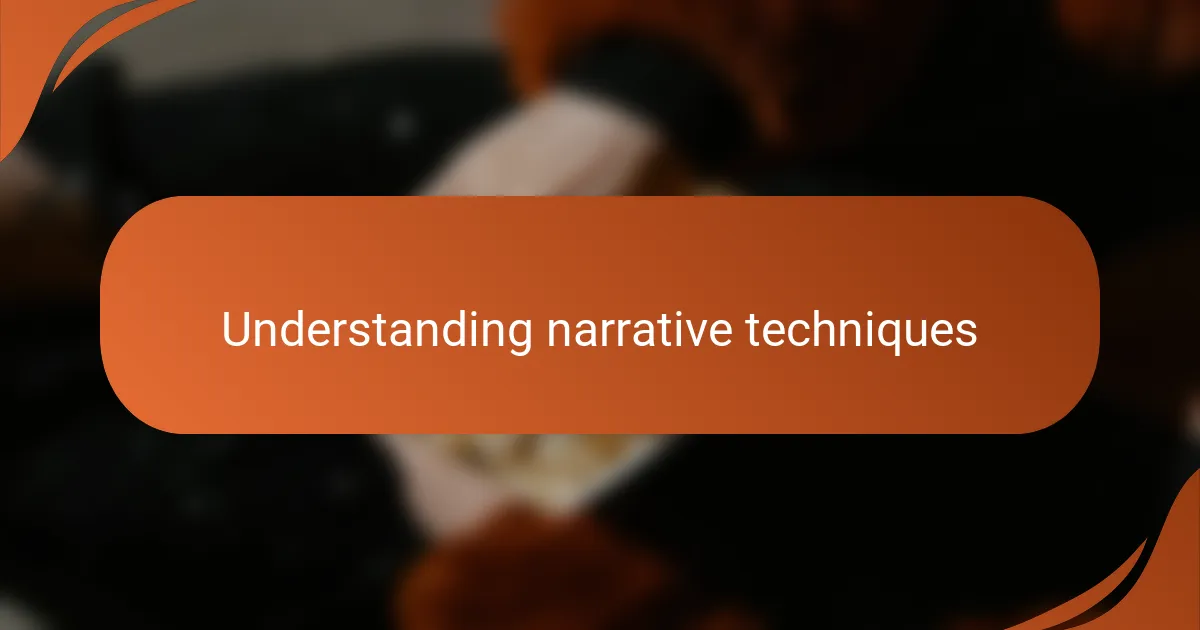
Understanding narrative techniques
Narrative techniques are the tools filmmakers use to tell a story in a way that feels alive and immersive. I’ve found that understanding these techniques deepens my appreciation for a film because it reveals the craft behind how emotions and ideas are conveyed. Have you ever noticed how a simple change in perspective can completely reshape your connection to the characters?
For me, narrative techniques are like the hidden language of cinema. When I first learned about nonlinear storytelling and how it challenges our sense of time, it made me rethink scenes that once seemed straightforward. It’s fascinating how something as subtle as pacing or voiceover narration can guide our feelings and thoughts without us even realizing it.
What strikes me most is how these techniques invite us to experience a story rather than just observe it. They make me wonder: how much of a film’s impact depends on the director’s choices in structuring the narrative? Exploring this question has always made watching movies a more active and emotionally rich experience for me.
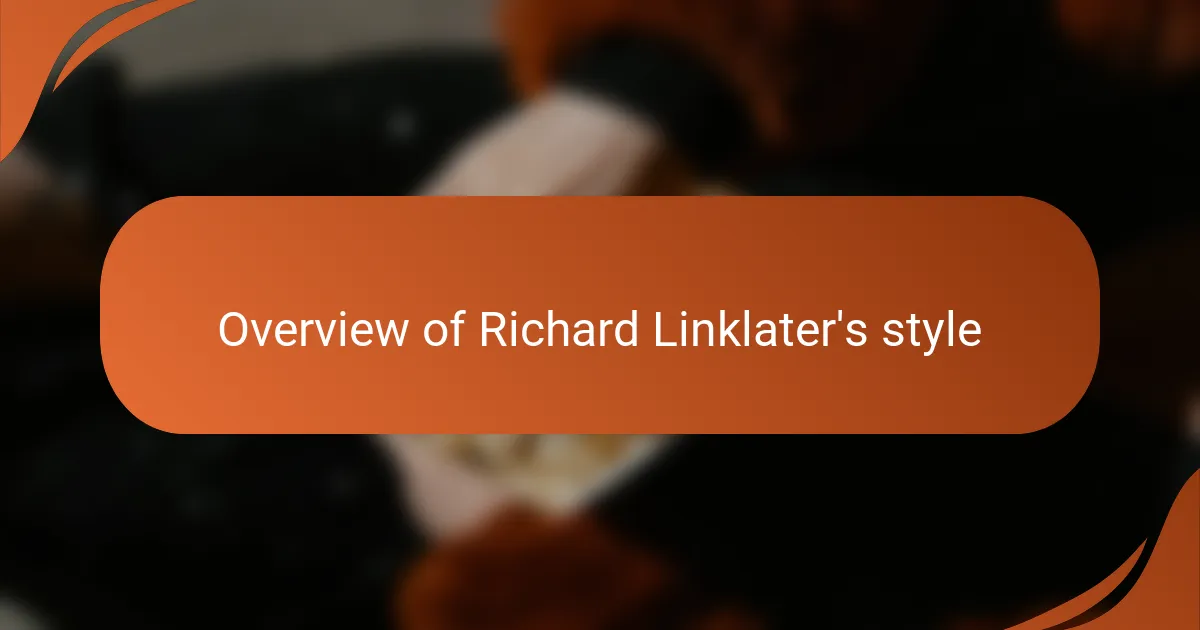
Overview of Richard Linklater’s style
Richard Linklater’s style feels refreshingly natural, almost like you’re eavesdropping on real conversations rather than watching scripted dialogue. I remember watching Before Sunrise and being struck by the casual flow of talk between the characters—it made me feel like their connection was unfolding in real time, not staged for the camera. Have you ever felt that a film’s dialogue was so authentic that you wished you could just step into the scene?
What I find compelling about Linklater’s approach is his use of time as a storytelling device. Instead of racing through events, he often zooms in on seemingly ordinary moments, letting them breathe and reveal deeper layers. This slows the pace but somehow makes the story feel more intimate and truthful, which I think is pretty rare in cinema today.
His blend of realism and experimentation keeps me intrigued. Whether it’s the grounded dialogue or the nonlinear timelines, Linklater invites the audience to actively piece together the narrative, making the experience personal and immersive. It makes me ask: how often do we get to truly live inside a film’s world rather than just watch it pass by?
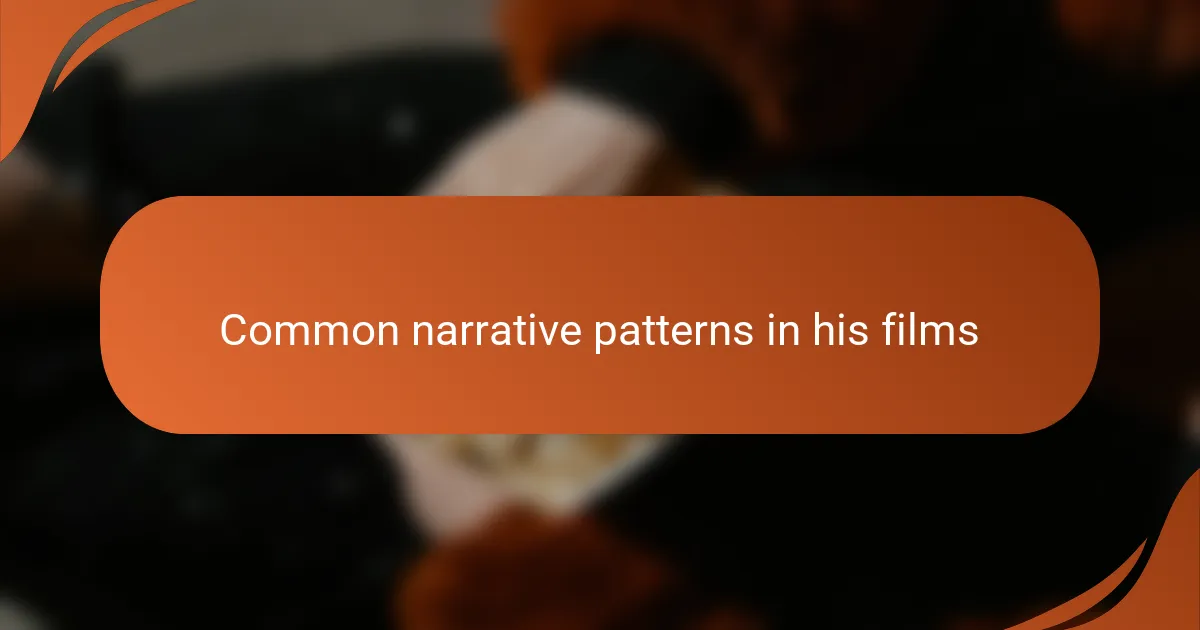
Common narrative patterns in his films
One narrative pattern I keep noticing in Linklater’s films is his focus on everyday conversations that reveal so much about characters without heavy exposition. It’s like he trusts the audience to catch the subtle emotional shifts in a casual chat. Have you ever found yourself hanging on every word in a seemingly simple dialogue, only to realize it’s the heartbeat of the story?
Another thing that stands out to me is his use of time as a circular or fragmented element, rather than a straight line. Films like Boyhood or the Before series unfold across years, almost letting us live through moments alongside the characters. This approach made me reflect on how time shapes us, not just in plot points but in quiet, almost imperceptible ways.
What really hits home is how he incorporates repetition and revisiting scenes or themes, creating a rhythm that feels both familiar and profound. It’s like listening to a favorite song where the chorus returns but with new meaning each time. Have you ever experienced that feeling in a Linklater film, where something familiar suddenly feels deeply new?

Analysis of narrative impact on audiences
The way Linklater structures his narratives often leaves me feeling like I’m part of an intimate conversation rather than a detached viewer. His naturalistic pacing and organic unfolding of events pull me in emotionally, making the experience more immersive and less about watching a story unfold from a distance. Have you ever felt so absorbed in a film that the boundaries between you and the characters just blur?
I’ve noticed that his technique of revisiting moments creates a sense of nostalgia and reflection that really resonates on a personal level. It’s as if each return to a scene brings fresh insight, not just for the characters but for me as an audience member trying to piece the story together. This narrative rhythm invites me to slow down and think about the subtleties I might’ve missed the first time.
What fascinates me most is how Linklater’s fragmented use of time challenges my expectations and keeps me emotionally engaged throughout. Instead of delivering a neat, chronological story, he trusts me to connect the dots, which makes the payoff feel earned and deeply satisfying. Do you find yourself replaying certain scenes in your mind long after the film ends? That, to me, is the mark of his narrative impact.
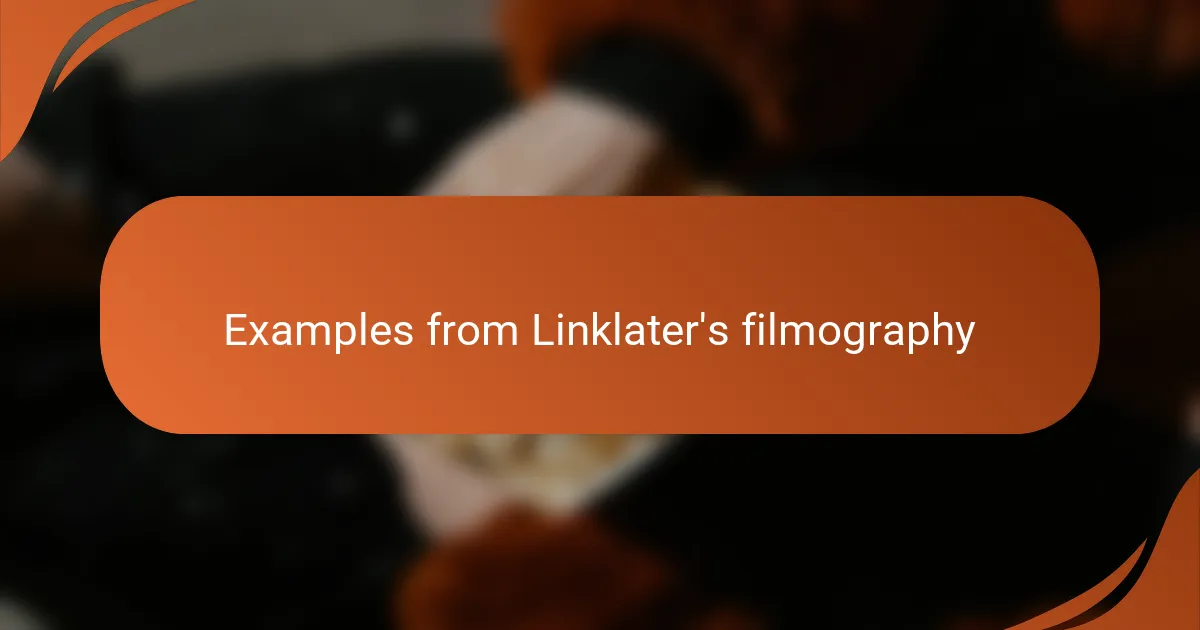
Examples from Linklater’s filmography
Linklater’s Before Sunrise immediately comes to mind when I think about his narrative techniques in action. The way the film relies almost entirely on dialogue-driven scenes makes me feel like I’m a fly on the wall during a genuine, unfolding romance. Have you ever watched a movie where the conversations feel so natural that you forget you’re watching a script? That’s exactly the immersive experience Linklater crafts here.
Then there’s Boyhood, which blew me away with its real-time aging of characters over 12 years. This narrative choice turned a coming-of-age story into a deeply personal journey, making me reflect on my own passage through time. I found myself emotionally invested in moments that might seem mundane in other films but felt monumental because they were lived alongside the characters.
Finally, in Waking Life, Linklater experiments with a dream-like narrative that defies traditional storytelling structures. It felt like being inside a philosophical conversation that ebbs and flows rather than a straightforward plot. This approach made me question how narrative form itself can shape not just the story, but our understanding of reality within a film. Have you ever watched a movie that felt more like a meditation than a story? That’s what this one did for me.
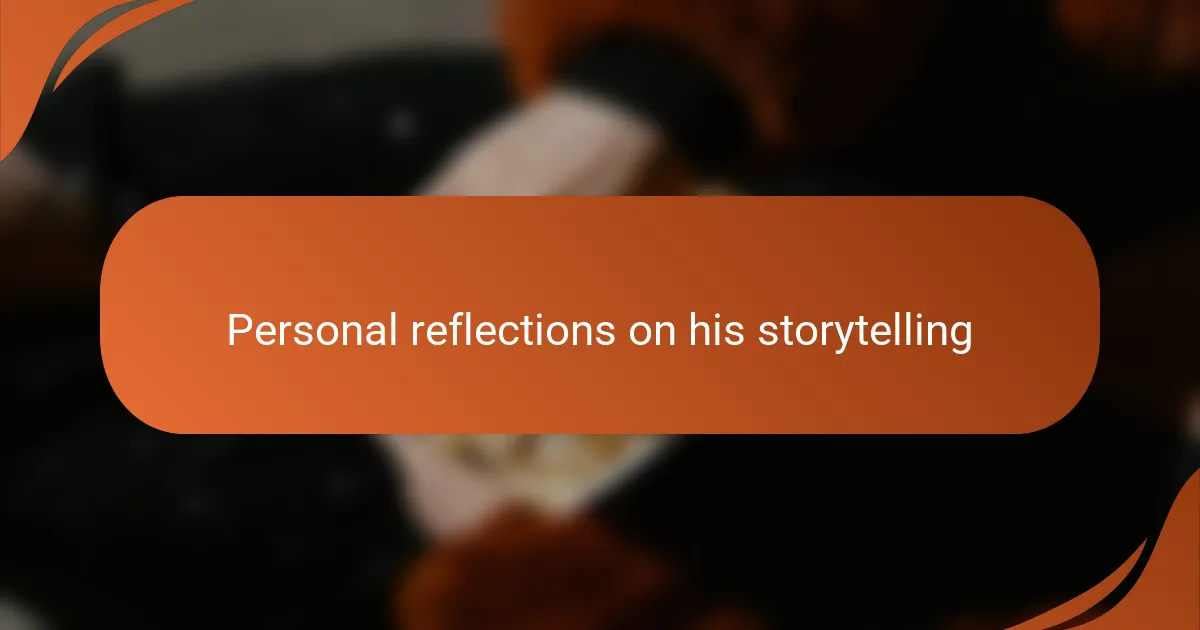
Personal reflections on his storytelling
What I find most striking about Linklater’s storytelling is how it often feels like a quiet invitation into someone’s inner world rather than a grand performance. Watching his films, I sometimes catch myself leaning in, as if not to miss a single nuance in conversation or gesture, because the emotional truth feels so immediate and unfiltered. Have you ever experienced that moment when a simple exchange between characters resonates with your own memories or feelings?
Another aspect that stays with me is his patience with time—the way he lets scenes unfold without rushing, almost daring me to sit with the silence or awkward pauses. At times, it’s uncomfortable but deeply honest, making the characters feel immensely real. I wonder if this slowing down helps me notice things about human connection I usually overlook in everyday life.
For me, Linklater’s narratives often blur the line between storyteller and listener, making me feel like a collaborator in uncovering meaning rather than just a spectator. It’s a rare kind of storytelling that invites questions and reflection, not just answers. Don’t you find that this approach leaves a lasting impression, prompting you to revisit scenes or conversations long after the credits roll?

Tips for applying his methods in reviews
When I apply Linklater’s methods in my reviews, I try to slow down and pay close attention to the everyday moments that might seem mundane at first glance. Have you ever caught yourself noticing how a simple pause or a casual line of dialogue reveals so much about a character? I find that highlighting these subtle details offers a more immersive and emotionally honest take on the film.
Another tip I lean on is embracing the non-linear or fragmented structure without feeling pressured to force everything into a neat summary. It’s tempting to want to lay out a film’s timeline clearly, but Linklater’s storytelling asks us to sit with ambiguity and fluid time. When I do this, my reviews become more reflective, inviting readers to experience the puzzle rather than just solving it for them.
Lastly, revisiting themes and scenes is something I like to emphasize in my writing. I often find myself returning to a moment or conversation that initially seemed minor but grew richer on reflection—just like in Before Sunrise or Boyhood. Have you ever been surprised by how a repeated scene deepens your understanding? Sharing that insight helps me connect with readers who appreciate a narrative that unfolds with layers and patience.